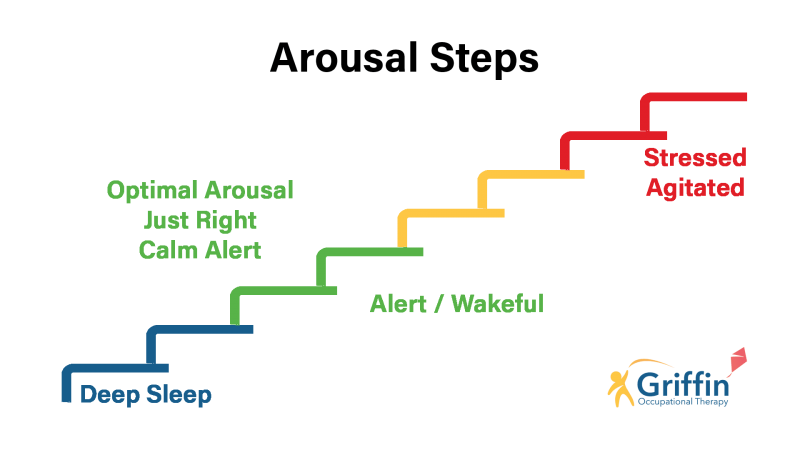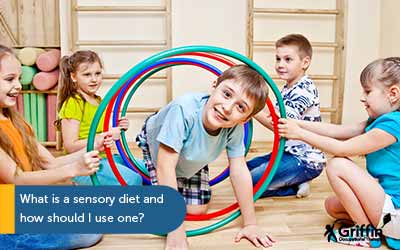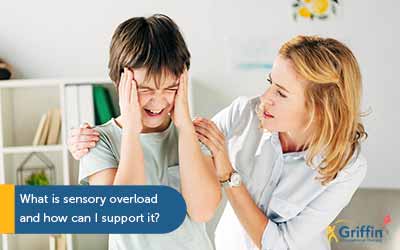Arousal is all about alertness
Arousal at its simplest is how awake or alert or how tired you are. It supports attention and focus. There are a number of things which impact an individuals’ level of arousal. This includes the sensory inputs from the environment as well as their body. In this post we will explore

Arousal is all about alertness
Arousal at its simplest is how awake or alert or how tired you are. It supports attention and focus. There are a number of things which impact an individuals’ level of arousal. This includes the sensory inputs from the environment as well as their body. In this post we will explore
What is arousal?
The term arousal relates to how awake or alert or how tired you are. Across a typical day it is very normal for arousal to fluctuate. Students, and teachers, need to constantly adjust their arousal levels throughout day and matching their arousal to the task and environment.
It can be helpful to think of arousal like steps, or a ladder. At the bottom there is sleep. At the top there is highly alert, agitated and stressed. Somewhere in the middle there is alert and wakeful. When arousal is too high or low, it is more difficult for individuals to access learning or to be successful at work.

Matching arousal with the environment and task
When considering arousal, it is important to note that there is no perfect level of arousal for every situation. In some environments, for example a library or cinema, it is expected that you would be quiet. However, in other environments, for example a sporting match or playground, it is expected that you would be much louder and engaged. Each environment has its own expectations and demands.
Tasks also require different levels of arousal. If you’re trying to get a baby to sleep, you will lower your level of arousal to help them sleep. You might sing a lullaby but you typically wouldn’t start blaring loud music at them. When playing a game of football, arousal levels need to be much higher to stay focussed and to keep up with the speed of the game.
Throughout the day, week and month every individual needs to adjust their level of arousal to match the environment and task. This adjusting is sometimes called regulation. Some individuals, particularly those with sensory differences, find this harder to do than others. They may need more support to reach optimal arousal.

Optimal arousal
Optimal arousal the level of arousal which matches the environment and activity. Sometimes it’s called ‘Just Right.’ At night time, optimal arousal is low enough to facilitate sleep. At school, optimal arousal is when a student can focus and attended. In the playground or at a party, it’s normal for optimal arousal to be a bit higher as there’s more movement and usually excitement.
Arousal and sensory processing
Students with sensory processing differences usually have more difficulty organising, or regulating, their arousal.

Jasper’s story
Jasper has some sensitivity to noise. This makes it harder for him to attend in class. Some sounds, like the lunch bell and the door slamming, make him startle. This increases his arousal and it takes him longer to calm down and refocus.
Some strategies that his teachers use to help to support him are headphones, a quieter space for lunch time and heavy work.
What impacts a person’s level of arousal?
There are a number of things that impact arousal levels.
There are many things that impact on arousal. Some might be obvious, like a loud sound. However, some might not be something you can immediately observe. Such as the child has not slept well or they are worried about a family member who is ill.
How to support optimal arousal
Supporting arousal will look different for each individual. Individuals with higher arousal will need sensory strategies to help to decrease their level of arousal. This will help them to focus and attend. Those who are slower to respond typically need more sensations to increase their arousal. This helps them to understand and process the experience. Because this is quite complex, Kim has written another article on how to support children to regulation their arousal. You an read it here – Sensory regulation strategies – What are they?
If you would like specific ideas for the classroom, then this article will also be relevant Sensory Strategies and Supports for the Classroom.
Kim also covers arousal and regulation in much further depth in GriffinOT’s online training.



